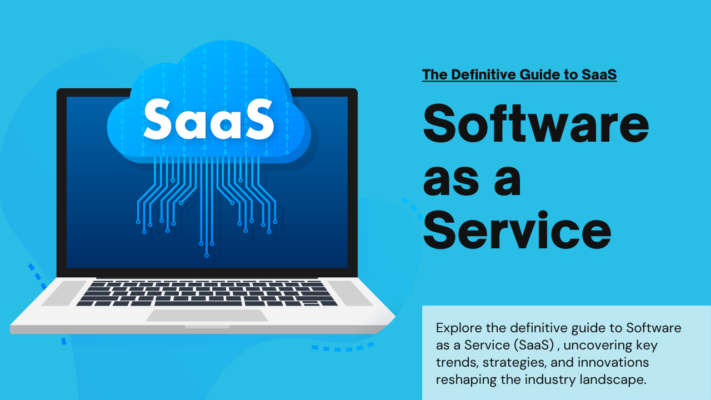
In today’s fast-paced digital era, businesses are constantly seeking ways to streamline operations, enhance efficiency, and reduce costs. One of the game-changing innovations that have transformed the way organizations access and utilize software is Software as a Service (SaaS). This cloud-based delivery model has revolutionized the software industry, offering a flexible, scalable, and cost-effective solution for businesses of all sizes. In this comprehensive blog post, we’ll delve into the world of Software as a Service, exploring its history, mechanics, challenges, benefits, types, and real-world examples.
What is SaaS (Software as a Service)?
Software as a Service (SaaS) is a cloud-based software delivery model where applications are hosted and managed by a third-party vendor and made available to users over the internet. Instead of installing and running software on local computers or servers, users access SaaS applications through a web browser or a dedicated client application. This approach eliminates the need for businesses to invest in expensive hardware, software licenses, and maintenance, as the vendor takes care of all the underlying infrastructure, updates, and support.
The history of SaaS
The concept of Software as a Service has its roots in the early days of the internet and cloud computing. While the term “SaaS” was coined in the late 1990s, the idea of delivering software over a network can be traced back to the 1960s with the advent of time-sharing systems and mainframe computing. However, it wasn’t until the widespread adoption of the internet and the development of web technologies in the late 1990s and early 2000s that SaaS truly began to gain traction.
Early pioneers of SaaS include companies like Salesforce, which launched its cloud-based customer relationship management (CRM) software in 1999, and Google, which introduced its suite of web-based productivity tools, including Gmail and Google Docs, in the early 2000s. As broadband internet became more widely available and cloud computing technologies advanced, Software as a Service rapidly gained popularity, offering businesses a more flexible, scalable, and cost-effective alternative to traditional on-premise software solutions.
How does SaaS work?
Software as a Service operates on a multi-tenant architecture, where a single instance of the software application is hosted and managed by the SaaS vendor and shared among multiple clients or tenants. Each tenant’s data is kept logically separate and secure, ensuring data privacy and isolation.
The process typically works as follows:
1. The SaaS vendor develops and maintains the software application, handling all aspects of its infrastructure, security, updates, and support.
2. Users access the SaaS application through a web browser or a dedicated client application, connecting to the vendor’s servers over the internet.
3. Data and information related to each user or organization are stored and managed by the SaaS vendor in their secure cloud environment.
4. The SaaS vendor provides regular updates, bug fixes, and new features to the application, ensuring that all users have access to the latest version without the need for manual updates or installations.
5. Users pay a subscription fee, typically based on the number of users, features, or usage, to access and utilize the SaaS application.
Challenges
While Software as a Service offers numerous benefits, it also comes with its own set of challenges that organizations need to consider:
1. Internet Dependency: SaaS applications rely heavily on a stable and high-speed internet connection, which can be a challenge in areas with poor connectivity or during network outages.
2. Data Security and Privacy: Since data is stored and managed by the SaaS vendor, organizations must ensure that the vendor has robust security measures in place to protect their sensitive data and comply with relevant data privacy regulations.
3. Integration and Compatibility: Integrating SaaS applications with existing on-premise systems or other cloud-based solutions can sometimes be challenging, requiring additional development efforts or third-party integration tools.
4. Vendor Lock-in: Switching from one SaaS vendor to another can be a complex and time-consuming process, as data migration and integration with new systems can be challenging, potentially leading to vendor lock-in.
5. Customization Limitations: While SaaS applications offer a certain degree of customization, organizations with highly specific or complex requirements may find it challenging to fully tailor the software to their needs.
Benefits of SaaS
Despite the challenges, Software as a Service offers numerous benefits that have made it a popular choice for businesses of all sizes:
1. Cost Savings: With SaaS, organizations can eliminate the need for expensive hardware, software licenses, and maintenance costs, as the vendor handles all infrastructure and updates.
2. Scalability and Flexibility: SaaS applications can be easily scaled up or down based on changing business needs, allowing organizations to pay only for the resources they require.
3. Accessibility and Mobility: Since SaaS applications are accessed over the internet, users can access them from anywhere, on any device with an internet connection, promoting mobility and remote work.
4. Automatic Updates and Maintenance: The SaaS vendor is responsible for maintaining the software, providing regular updates, and ensuring the application is up-to-date with the latest features and security patches.
5. Reduced IT Overhead: By outsourcing software management and maintenance to the SaaS vendor, organizations can reduce their IT overhead and focus resources on core business activities.
6. Collaboration and Collaboration: Many SaaS applications are designed with collaboration and teamwork in mind, enabling seamless sharing and real-time collaboration among team members, regardless of their location.
Types of SaaS Products
Software as a Service encompasses a wide range of applications and solutions across various industries and business functions. Some of the most common types of SaaS products include:
1. Customer Relationship Management (CRM): SaaS-based CRM solutions like Salesforce, HubSpot, and Zoho CRM help businesses manage customer data, sales pipelines, and customer interactions more effectively.
2. Enterprise Resource Planning (ERP): Cloud-based ERP systems like NetSuite, Oracle Cloud ERP, and SAP SuccessFactors streamline business processes, financial management, and supply chain operations.
3. Productivity and Collaboration Tools: Products like Google Workspace (formerly G Suite), Microsoft Office 365, and Dropbox provide cloud-based productivity tools for document creation, storage, and collaboration.
4. Project Management and Collaboration: SaaS solutions like Asana, Trello, and Jira help teams manage projects, tasks, and workflows more efficiently.
5. Human Resource Management (HRM): SaaS-based HRM platforms like BambooHR, Gusto, and Workday simplify HR processes, including recruitment, payroll, and employee management.
6. Marketing and Analytics: SaaS products like HubSpot, Marketo, and Google Analytics offer powerful marketing automation, lead generation, and data analytics capabilities.
7. Cloud Storage and File Sharing: Services like Dropbox, Box, and Google Drive provide secure cloud storage and file sharing solutions for businesses.
SaaS Examples
Here are some popular examples of Software as a Service products across various industries and categories:
1. Salesforce (CRM)
2. Microsoft Office 365 (Productivity and Collaboration)
3. Slack (Collaboration and Communication)
4. Hubspot (Marketing and Sales)
5. Zendesk (Customer Service and Support)
6. QuickBooks Online (Accounting and Finance)
7. Asana (Project Management)
8. Workday (Human Resource Management)
9. Shopify (E-commerce)
10. Adobe Creative Cloud (Creative and Design)
SaaS Pricing Models
Software as a Service providers typically offer various pricing models to cater to the diverse needs and budgets of their customers. Some common SaaS pricing models include:
1. Subscription-based: This is the most common pricing model, where users pay a recurring fee, typically monthly or annually, to access the SaaS application.
2. Usage-based: In this model, users are charged based on their actual usage of the SaaS application, such as the number of transactions, storage space, or API calls.
3. Freemium: Many SaaS providers offer a free basic version of their application with limited features, and users can upgrade to a paid version with additional functionality.
4. Per-user or Per-seat: In this model, the pricing is based on the number of users or seats within an organization that require access to the SaaS application.
5. Feature-based: Some SaaS providers offer different pricing tiers based on the features and functionalities included, allowing users to choose the plan that best fits their needs.
SaaS vs. on-premise
When deciding between Software as a Service and traditional on-premise software solutions, organizations need to consider several factors:
1. Cost: SaaS typically has lower upfront costs and predictable recurring fees, while on-premise solutions require significant upfront investments in hardware, software licenses, and IT infrastructure.
2. Scalability: SaaS applications are highly scalable, allowing organizations to easily adjust their usage and resources based on changing needs, while scaling on-premise solutions
3. Maintenance and Updates: With SaaS, the vendor handles all maintenance, updates, and security patches, while on-premise solutions require dedicated IT resources and efforts for ongoing maintenance and updates.
4. Accessibility: SaaS applications can be accessed from anywhere with an internet connection, promoting mobility and remote work, while on-premise solutions are typically confined to specific locations or local networks.
5. Customization: While SaaS applications offer some degree of customization, on-premise solutions generally provide more flexibility for extensive customization and integration with existing systems.
6. Data Control and Security: On-premise solutions offer more control over data storage and security, as the data resides within the organization’s infrastructure. With SaaS, data is stored and managed by the vendor, raising potential concerns about data privacy and compliance.
The best SaaS for your business
Choosing the right SaaS solution for your business depends on several factors, including your industry, business size, specific requirements, and budget. Here are some general guidelines to help you select the best SaaS for your business:
1. Define your business needs: Clearly identify the specific functionalities and features you require from a SaaS application, such as CRM, project management, or marketing automation.
2. Evaluate industry-specific solutions: Look for SaaS providers that specialize in your industry or offer solutions tailored to your specific business needs.
3. Consider scalability and growth potential: Choose a SaaS solution that can easily scale as your business grows, allowing you to add more users, features, or resources as needed.
4. Assess integration capabilities: Evaluate how well the SaaS application can integrate with your existing systems, tools, and workflows to ensure seamless operations.
5. Review security and compliance: Ensure that the SaaS provider adheres to industry-specific security and compliance standards, such as GDPR, HIPAA, or PCI-DSS, to protect your data and maintain regulatory compliance.
6. Evaluate customer support and training: Consider the level of customer support, training resources, and documentation provided by the SaaS vendor to ensure a smooth implementation and ongoing support.
7. Analyze pricing and total cost of ownership: Compare pricing models, additional fees, and the overall total cost of ownership (TCO) of different SaaS solutions to find the best value for your budget.
SaaS Streamlines Operations and Eases Business Costs
Software as a Service has revolutionized the way businesses access and utilize software solutions. By leveraging cloud-based delivery models, SaaS offers numerous benefits, including cost savings, scalability, accessibility, and reduced IT overhead. From CRM and ERP systems to productivity tools and marketing automation, SaaS has permeated various industries and business functions, providing organizations with flexible, efficient, and cost-effective solutions.
As technology continues to evolve, the adoption of SaaS is expected to grow even further, driven by the increasing demand for mobility, remote work, and the need for agile and scalable solutions. However, it’s crucial for businesses to carefully evaluate their specific needs, security requirements, and integration challenges to select the right SaaS products that align with their goals and strategies.
If you’re looking to leverage the power of Software as a Service for your business, consider partnering with Upcore Technologies. Our team of experts specializes in providing comprehensive technology solutions, including AI Consulting, Machine Learning Services, RPA solutions, and Computer Vision services. We stay ahead of the curve by closely following the latest AI Trends and Machine Learning Trends, ensuring that our clients receive cutting-edge solutions tailored to their unique business needs.
By working with Upcore Technologies, you can unlock the full potential of SaaS and other emerging technologies, streamlining your operations, enhancing efficiency, and driving innovation within your organization. Contact us today to embark on a transformative journey and stay ahead in the ever-evolving digital landscape.


